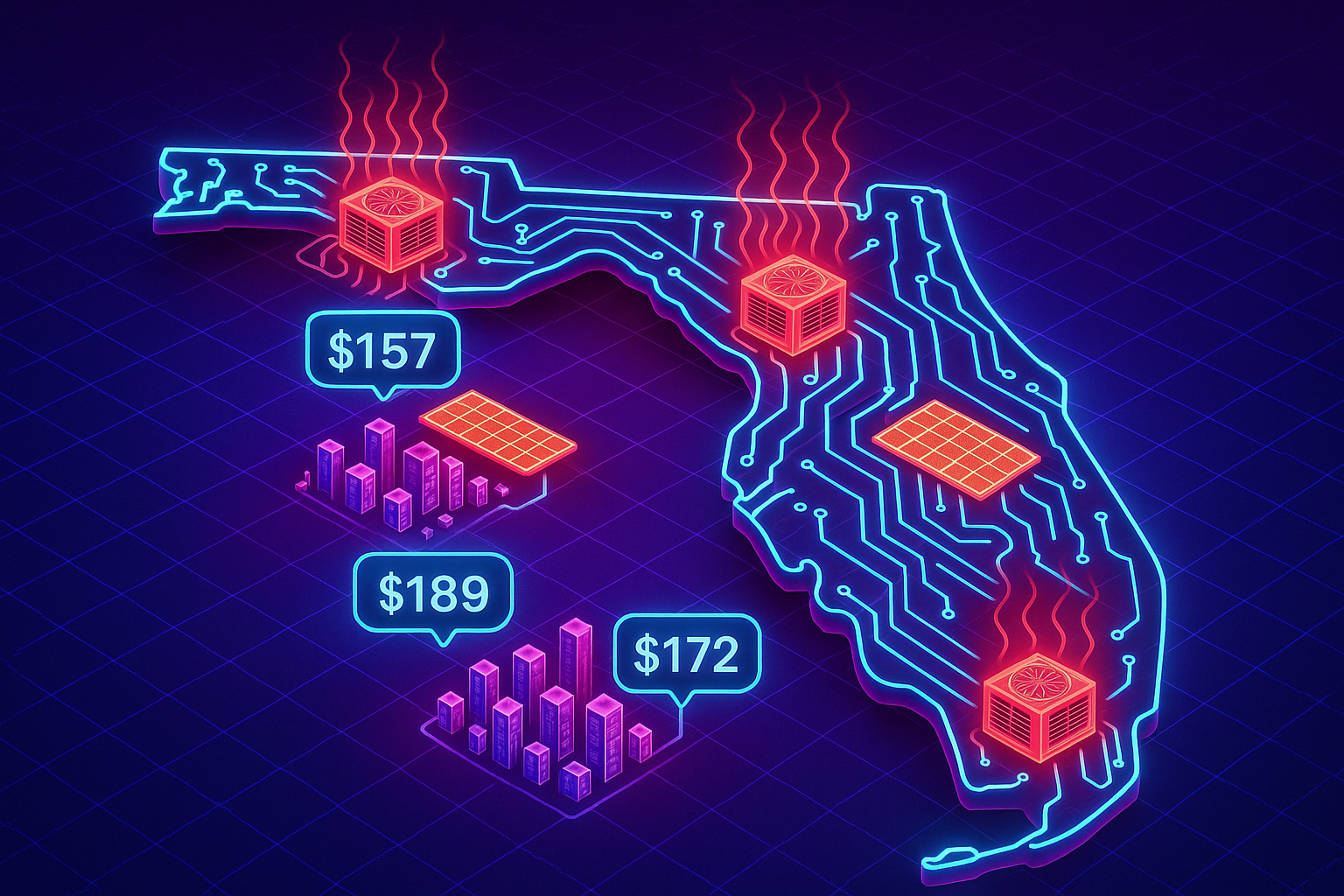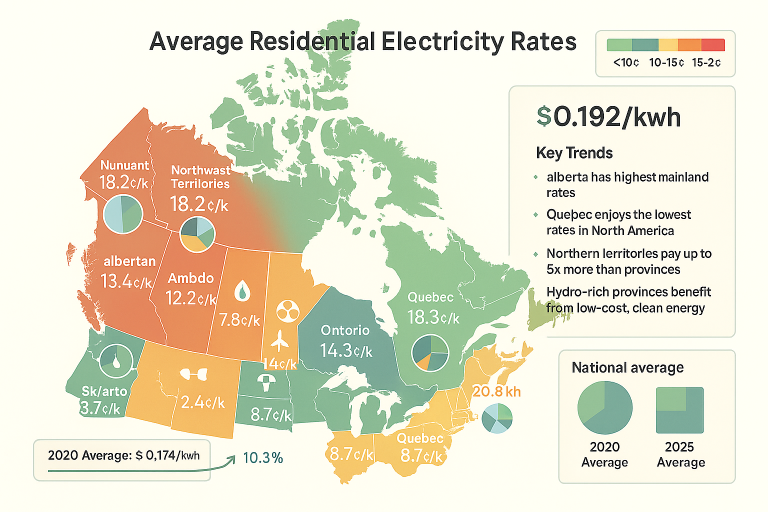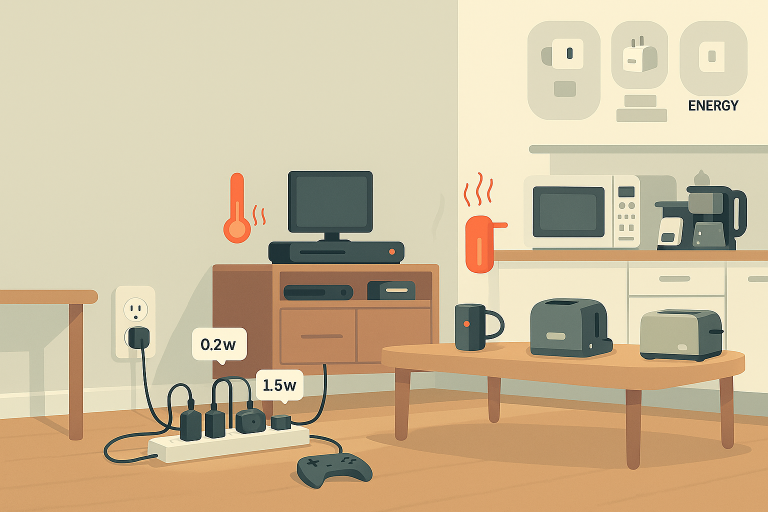Understanding Florida’s Energy Costs in 2025
Florida is known for its warm climate, sprawling suburbs, and rapid population growth. But for many residents, one of the most surprising aspects of life in the Sunshine State is the size of their monthly electric bill. In 2025, Florida ranks among the top 10 states for the highest average residential electricity bills, despite having a relatively low rate per kilowatt-hour (kWh).
In this article, we’ll explore the factors driving up energy costs in Florida, how the state compares nationally, and what residents can do to manage or reduce their electricity expenses.
Current Snapshot: Florida’s Electricity Costs in 2025
As of 2025, Florida’s electricity costs reflect a combination of high usage and rising rates. Here’s a detailed breakdown:
| Metric | Florida | U.S. Average |
|---|---|---|
| Monthly Bill | $157–$169 | $140.56 |
| Monthly Consumption | 1,107–1,785 kWh | 855 kWh |
| Rate per kWh | 14–16 cents | 16.44 cents |
| Bill Rank Among States | 8th Highest | N/A |
Although Florida’s per-kWh cost is slightly below the national average, its high electricity consumption pushes the total bill significantly higher. The state’s warm and humid climate means air conditioning is essential for most of the year, driving up usage and costs.
Why Are Florida’s Bills So High?
Several key factors contribute to Florida’s high electricity bills:
1. Climate-Driven Consumption
Florida’s tropical climate is the primary driver of high energy use. Air conditioning accounts for about half of the average household’s electricity consumption. With summer temperatures regularly exceeding 90°F and high humidity, cooling systems run nearly continuously.
In contrast, northern states like Maine report average monthly usage of just 560 kWh. Florida households, by comparison, use up to 65% more electricity than the national average.
2. Fuel Dependency and Infrastructure
Over 75% of Florida’s electricity comes from natural gas. While natural gas is efficient and relatively clean, it is also subject to global price volatility. Events such as the war in Ukraine and global supply chain disruptions have led to sharp increases in fuel costs, which are passed on to consumers.
Additionally, Florida’s aging power grid and frequent hurricane damage—such as from Hurricane Ian in 2022—have added to infrastructure costs. Utilities have introduced storm recovery fees averaging $5–$10 per month to cover repair and resilience upgrades.
3. Regulatory and Rate Hikes
Major utility providers, particularly Florida Power & Light (FPL), have requested and received multi-year rate increases. FPL’s proposed rate hikes, effective from 2026 to 2029, could add $8–$17 to monthly bills. These increases include a rise in base charges from $25 to $30 per month, affecting even low-usage customers.
These changes are partly driven by investments in grid modernization, storm hardening, and new power generation facilities.
Regional Variations: Where Bills Are Highest and Lowest
Electricity costs vary widely across Florida, depending on the utility provider and local regulations.
| Utility Provider | Average Rate per kWh | Notes |
|---|---|---|
| Florida Power & Light (FPL) | 17 cents | Highest in state |
| Duke Energy Florida | 14 cents | Seasonal rate fluctuations |
| Florida Public Utilities | 15 cents | Consistent pricing |
| Municipal Utilities (e.g., Mount Dora) | 11–13 cents | Lowest rates via public power |
Residents served by municipal or public utilities often enjoy significantly lower bills than those served by investor-owned utilities like FPL or Duke Energy. For example, customers in cities like Mount Dora or Alachua pay $26–$33 less per 1,000 kWh compared to those under FPL.
Historical Trends: Rising Rates, Rising Anxiety
Florida’s electricity costs have been on an upward trend for years, with 2025 marking another peak in average monthly bills.
- From 2023 to 2025, rates dipped slightly after a spike in 2023 due to global gas prices, but the overall trend remains upward.
- Since 2020, natural gas price volatility has pushed rates up by 25%.
- The rise of energy-intensive industries like data centers and electric vehicle (EV) charging has increased demand faster than the grid can expand or modernize.
These pressures are expected to continue, with utilities planning further rate increases to fund infrastructure upgrades and renewable energy investments.
5 Ways to Slash Your Florida Electric Bill
Despite the rising costs, there are several strategies Florida residents can use to reduce their monthly energy bills:
1. Invest in Solar Energy
Florida’s abundant sunshine makes it an ideal location for solar power. With over 230 sunny days per year, homeowners can significantly offset their electricity use by installing solar panels.
- A 14.2 kW system can fully offset the average Florida household’s energy needs.
- Federal tax credits cover 30% of installation costs for both solar panels and battery storage.
- Net metering policies allow homeowners to sell excess electricity back to the grid at full retail rates.
Over a 20-year period, the average Florida homeowner can save more than $91,500 by switching to solar.
2. Improve Home Efficiency
Simple upgrades can make a big difference in energy use:
- Seal ductwork to reduce air conditioning loss by up to 20%.
- Install programmable or smart thermostats to optimize cooling schedules.
- Replace old appliances with ENERGY STAR-rated models, which can reduce energy use by 10–30%.
3. Take Advantage of Time-of-Use Plans
Many utilities offer time-of-use (TOU) plans that charge different rates depending on the time of day. Shifting energy-intensive activities like laundry and dishwashing to off-peak hours (typically after 8 PM) can reduce costs by up to 25%.
4. Add Battery Backup Systems
Pairing solar panels with a battery storage system allows homeowners to store excess energy for use during peak hours or power outages. Systems like the EcoFlow OCEAN Pro provide resilience during hurricanes and help avoid high demand charges.
5. Apply for Energy Assistance Programs
Low-income households may qualify for assistance through programs like:
- LIHEAP (Low-Income Home Energy Assistance Program): Helps with utility bills and home weatherization.
- Florida’s Department of Economic Opportunity: Offers energy assistance and emergency services for qualifying residents.
Solar: Florida’s $30,000 Power Bill Solution
Solar energy is not just an environmental choice—it’s a powerful financial tool for Florida homeowners.
- The average payback period for a solar installation is just 9.77 years.
- Solar panels are built to withstand hurricane-force winds (up to 160 mph), offering both energy independence and home protection.
- Adding battery storage allows homeowners to use solar power at night and during grid outages.
With federal incentives and rising utility rates, solar adoption is more attractive than ever.
Future Outlook: Challenges and Opportunities
Looking ahead, Florida’s energy landscape will continue to evolve. While short-term rate increases are likely, there are also promising developments:
- FPL and other utilities plan to invest heavily in solar farms and battery storage, aiming to reach 40% clean energy by 2040.
- Community solar programs are expanding, allowing renters and apartment dwellers to benefit from solar energy without installing panels.
- Rate hikes from FPL could push average monthly bills to $180 or more by 2029, making energy efficiency and solar adoption even more critical.
Take Control of Your Energy Destiny
Florida’s high electric bills are the result of a complex mix of climate, infrastructure, and market forces. While the state’s electricity rates per kWh are relatively low, the high demand for cooling and rising fuel costs drive up total monthly expenses.
However, Florida residents have more tools than ever to manage and reduce these costs. From solar energy and energy efficiency upgrades to smart rate plans and assistance programs, there are real solutions available today.
The Sunshine State’s greatest asset—its abundant sunlight—may ultimately be the key to a more affordable and resilient energy future.






